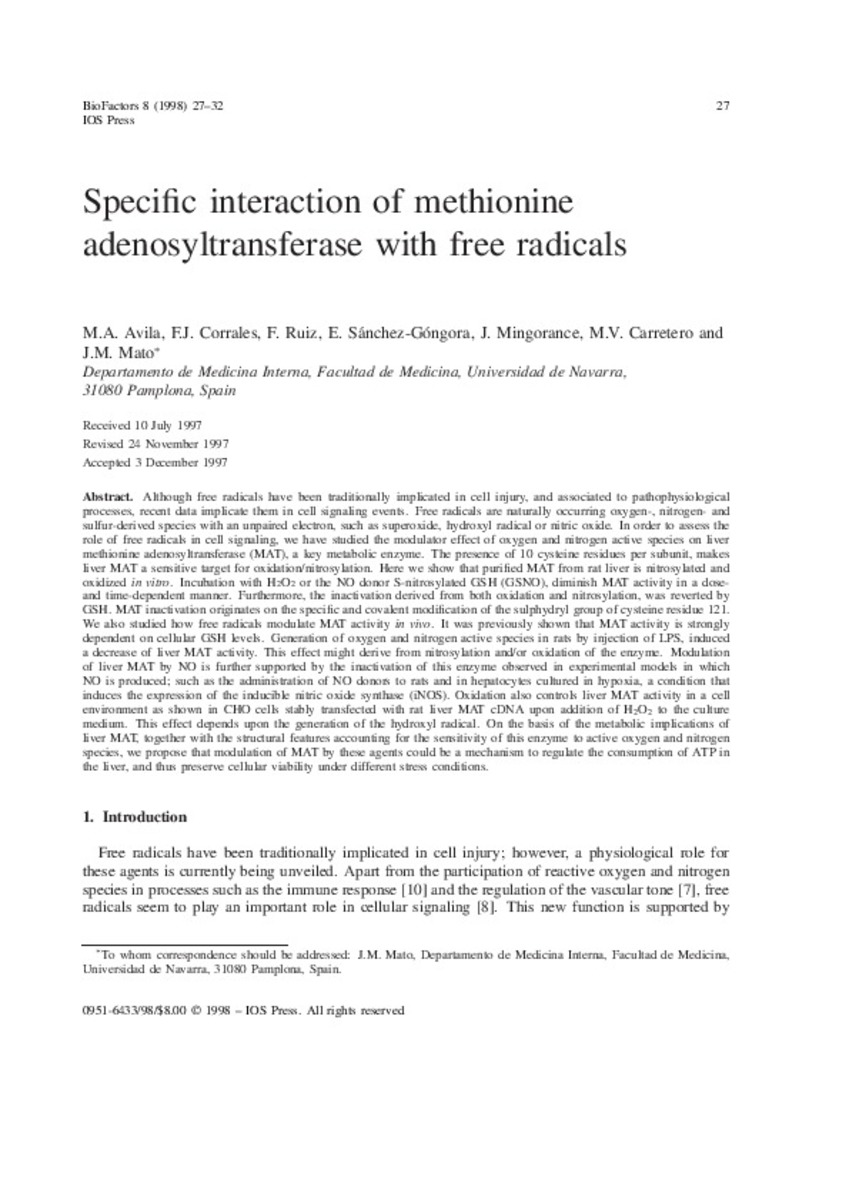Full metadata record
| DC Field | Value | Language |
|---|---|---|
| dc.creator | Avila, M.A. (Matías Antonio) | - |
| dc.creator | Corrales, F.J. (Fernando José) | - |
| dc.creator | Ruiz, F.A. (Félix A.) | - |
| dc.creator | Sanchez-Gongora, E. (E.) | - |
| dc.creator | Mingorance, J. (J.) | - |
| dc.creator | Carretero, M.V. (M. Victoria) | - |
| dc.creator | Mato, J.M. (José María) | - |
| dc.date.accessioned | 2012-03-26T12:44:47Z | - |
| dc.date.available | 2012-03-26T12:44:47Z | - |
| dc.date.issued | 1998 | - |
| dc.identifier.citation | Avila MA, Corrales FJ, Ruiz F, Sanchez-Gongora E, Mingorance J, Carretero MV, et al. Specific interaction of methionine adenosyltransferase with free radicals. Biofactors 1998;8(1-2):27-32. | es_ES |
| dc.identifier.issn | 1872-8081 | - |
| dc.identifier.uri | https://hdl.handle.net/10171/21344 | - |
| dc.description.abstract | Although free radicals have been traditionally implicated in cell injury, and associated to pathophysiological processes, recent data implicate them in cell signaling events. Free radicals are naturally occurring oxygen-,nitrogen-and sulfur-derived species with an unpaired electron, such as superoxide, hydroxyl radical or nitric oxide. In order to assess the role of free radicals in cell signaling, we have studies the modulator effect of oxygen and nitrogen active species on liver methionine adenosyltransferase (MAT), a key metabolic enzyme. The presence of 10 cysteine residues per subunit, makes liver MAT a sensitive target for oxidation/nitrosylation. Here we show that purified MAT from rat liver is nitrosylated and oxidized in vitro. Incubation with H202 or the NO donor S-nitrosylated GSH (GSNO), diminish MAT activity in a dose-and time-dependent manner. Furthermore, the inactivation derived from both oxidation and nitrosylation, was reverted by GSH. MAT inactivation originates on the specific and covalent modification of the sulphydryl group of cysteine residue 121. We also studied how free radicals modulate MAT activity in vivo. It was previously shown that MAT activity is strongly dependent on cellular GSH levels. Generation of oxygen and nitrogen active species in rats by injection of LPS, induced a decrease of liver MAT activity. This effect might derive from nitrosylation and/or oxidation of the enzyme. Modulation of liver MAT by NO is further supported by the inactivation of this enzyme observed in experimental models in which NO is produced; such as the administration of NO donors to rats and in hepatocytes cultured in hypoxia, a condition that induces the expression of the inducible nitric oxide synthase (iNOS). Oxidation also controls liver MAT activity in a cell environment as shown in CHO cells stably transfected with rat liver MAT cDNA upon addition of H2O2 to the culture medium. This effect depends upon the generation of the hydroxyl radical. On the basis of the metabolic implications of liver MAT, together with the structural features accounting for the sensitivity of this enzyme to active oxygen and nitrogen species, we propose that modulation of MAT by these agents could be a mechanism to regulate the consumption of ATP in the liver, and thus preserve cellular viability under different stress conditions. | es_ES |
| dc.language.iso | eng | es_ES |
| dc.publisher | Wiley-Blackwell | es_ES |
| dc.rights | info:eu-repo/semantics/openAccess | es_ES |
| dc.subject | Glutathione/metabolism | es_ES |
| dc.subject | Methionine Adenosyltransferase/metabolism | es_ES |
| dc.subject | Oxidative Stress/physiology | es_ES |
| dc.title | Specific interaction of methionine adenosyltransferase with free radicals | es_ES |
| dc.type | info:eu-repo/semantics/article | es_ES |
| dc.relation.publisherversion | http://www.swetswise.com/eAccess/viewAbstract.do?articleID=150487756 | es_ES |
| dc.type.driver | info:eu-repo/semantics/article | es_ES |
Files in This Item:
Statistics and impact
Items in Dadun are protected by copyright, with all rights reserved, unless otherwise indicated.






